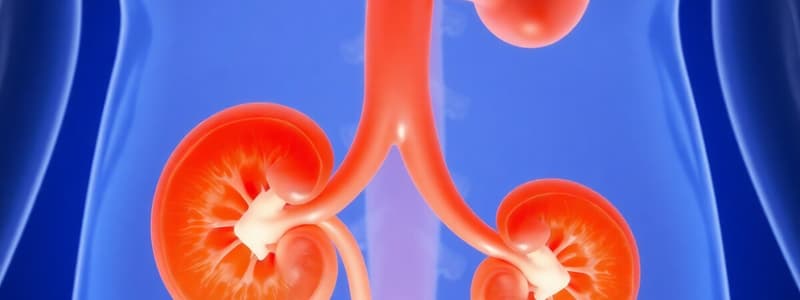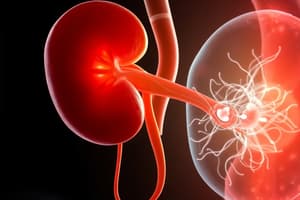Podcast
Questions and Answers
What is the primary complication associated with horseshoe kidney?
What is the primary complication associated with horseshoe kidney?
- Increased risk of kidney stones and infections (correct)
- Increased risk of pulmonary hypoplasia
- Higher incidence of ectopic pregnancy
- Higher chance of developing duplicated ureters
Which condition involves the fusion of the inferior poles of the kidneys during ascent?
Which condition involves the fusion of the inferior poles of the kidneys during ascent?
- Renal agenesis
- Horseshoe kidney (correct)
- Supernumerary kidney
- Polycystic kidney disease
What is the function of Tolvaptan in the treatment of ADPKD?
What is the function of Tolvaptan in the treatment of ADPKD?
- It promotes nephrons development
- It directly stimulates kidney regeneration
- It reduces cyst growth and preserves kidney function (correct)
- It is a diuretic that increases urine output
Which imaging technique is typically used to detect ectopic kidney?
Which imaging technique is typically used to detect ectopic kidney?
What anatomical structure is primarily responsible for the obstruction in horseshoe kidney conditions?
What anatomical structure is primarily responsible for the obstruction in horseshoe kidney conditions?
What is the consequence of bilateral renal agenesis?
What is the consequence of bilateral renal agenesis?
Which of the following statements about duplicated ureters is true?
Which of the following statements about duplicated ureters is true?
What is the typical timing of nephron function becoming operational during gestation?
What is the typical timing of nephron function becoming operational during gestation?
What is the primary function of the pronephros during kidney development?
What is the primary function of the pronephros during kidney development?
During which week of gestation does the mesonephros appear?
During which week of gestation does the mesonephros appear?
Which anatomical structures are formed from the ureteric bud?
Which anatomical structures are formed from the ureteric bud?
What major change occurs in the blood supply of the kidneys during their ascent?
What major change occurs in the blood supply of the kidneys during their ascent?
What congenital anomaly refers to the absence of one or both kidneys?
What congenital anomaly refers to the absence of one or both kidneys?
What is the characteristic feature of a hypoplastic kidney?
What is the characteristic feature of a hypoplastic kidney?
At what stage does the metanephros begin to develop into the permanent kidney?
At what stage does the metanephros begin to develop into the permanent kidney?
Which developmental structure is primarily responsible for initiating the formation of nephrons?
Which developmental structure is primarily responsible for initiating the formation of nephrons?
Which imaging method is considered first-line for detecting renal agenesis?
Which imaging method is considered first-line for detecting renal agenesis?
What distinguishes Polycystic Kidney Disease (ADPKD) from simple renal cysts?
What distinguishes Polycystic Kidney Disease (ADPKD) from simple renal cysts?
What is the clinical significance of compensatory hypertrophy of the remaining kidney seen in renal agenesis?
What is the clinical significance of compensatory hypertrophy of the remaining kidney seen in renal agenesis?
Which management strategy is commonly employed in ADPKD to delay disease progression?
Which management strategy is commonly employed in ADPKD to delay disease progression?
Which congenital anomaly may arise due to disruptions in kidney ascent during development?
Which congenital anomaly may arise due to disruptions in kidney ascent during development?
In what stage does the metanephros form the definitive kidney during gestation?
In what stage does the metanephros form the definitive kidney during gestation?
Which of the following is NOT typically a clinical consequence of congenital kidney anomalies?
Which of the following is NOT typically a clinical consequence of congenital kidney anomalies?
What imaging technique provides detailed visualization for complex renal conditions such as ectopic kidneys?
What imaging technique provides detailed visualization for complex renal conditions such as ectopic kidneys?
Flashcards
Ectopic Kidney
Ectopic Kidney
A kidney located outside its normal position, typically in the pelvis.
Supernumerary Kidney
Supernumerary Kidney
Presence of more than two kidneys.
Horseshoe Kidney
Horseshoe Kidney
Fusion of the inferior poles of both kidneys during ascent.
Duplicated Ureter
Duplicated Ureter
Signup and view all the flashcards
Renal Agenesis
Renal Agenesis
Signup and view all the flashcards
Polycystic Kidney Disease (ADPKD)
Polycystic Kidney Disease (ADPKD)
Signup and view all the flashcards
Horseshoe Kidney (Treatment)
Horseshoe Kidney (Treatment)
Signup and view all the flashcards
Tolvaptan
Tolvaptan
Signup and view all the flashcards
Pronephros
Pronephros
Signup and view all the flashcards
Mesonephros
Mesonephros
Signup and view all the flashcards
Metanephros
Metanephros
Signup and view all the flashcards
Ureteric Bud
Ureteric Bud
Signup and view all the flashcards
Metanephric Blastema
Metanephric Blastema
Signup and view all the flashcards
Ascent of the Kidneys
Ascent of the Kidneys
Signup and view all the flashcards
Hypoplastic Kidney
Hypoplastic Kidney
Signup and view all the flashcards
Ultrasound in Kidney Evaluation
Ultrasound in Kidney Evaluation
Signup and view all the flashcards
CT Scan/MRI in Kidney Evaluation
CT Scan/MRI in Kidney Evaluation
Signup and view all the flashcards
Genetic Testing for ADPKD
Genetic Testing for ADPKD
Signup and view all the flashcards
Polycystic Kidney Disease (ADPKD) Management
Polycystic Kidney Disease (ADPKD) Management
Signup and view all the flashcards
Study Notes
Renal and Urinary System Development
- The kidney develops through three stages: pronephros, mesonephros, and metanephros.
- The metanephros forms the permanent kidney by the 10th week of gestation.
- Congenital anomalies like renal agenesis, horseshoe kidneys, and duplicated ureters arise from disruptions during kidney development and ascent.
- These anomalies can cause recurrent infections, kidney stones, or renal failure.
- Polycystic Kidney Disease (ADPKD) is a progressive genetic disorder, often leading to renal failure.
- Management typically includes blood pressure control and medication like Tolvaptan, aiming to delay disease progression.
Key Kidney Developmental Stages
- Pronephros: The initial, non-functional stage, regresses by the 4th week.
- Mesonephros: A temporarily functional stage, crucial for male reproductive development.
- Metanephros: The permanent kidney, develops from the ureteric bud and metanephric blastema.
Key Concepts and Structures
- Ureteric Bud: Forms the ureter, renal pelvis, calyces, and collecting ducts.
- Metanephric Blastema: Grows into the nephrons (glomeruli, tubules).
- Kidneys ascend: From pelvic to abdominal position between weeks 6 and 9.
- Blood supply changes during ascent.
Congenital Anomalies
- Renal Agenesis: Absence of one or both kidneys.
- Hypoplastic Kidney: Smaller kidney, fewer nephrons.
- Supernumerary Kidney: More than two kidneys.
- Ectopic Kidney: Abnormal kidney placement (e.g., pelvis).
- Horseshoe Kidney: Fusion of the inferior poles.
- Duplicated Ureter: Two ureters from one kidney.
Clinical Applications
- Clinical Presentation of Horseshoe Kidney: Increased risk of kidney stones, infections.
- Diagnosis: Imaging (ultrasound, CT/MRI) is key.
- ADPKD management aims at slowing progression and managing complications.
Pathology - Kidney Development
- Kidney development follows a cranial-to-caudal sequence.
- Pronephros regresses, allowing for mesonephros development.
- Metanephros is the definitive kidney.
- Abnormal development leads to congenital anomalies.
Pharmacology
- Tolvaptan: Reduces cyst growth in ADPKD by acting on vasopressin receptors.
- NSAIDS: Can be used to manage flank pain related to conditions like kidney stones and ADPKD.
Differential Diagnosis
- Distinguish renal agenesis from renal hypoplasia based on imaging.
- Differentiate ADPKD from simple renal cysts based on imaging and family history.
Investigations
- Ultrasound: Primarily for initial kidney imaging.
- CT/MRI: For complex cases, providing detailed images.
- Genetic testing: Useful for diagnosing ADPKD, especially in cases with a family history.
Studying That Suits You
Use AI to generate personalized quizzes and flashcards to suit your learning preferences.




